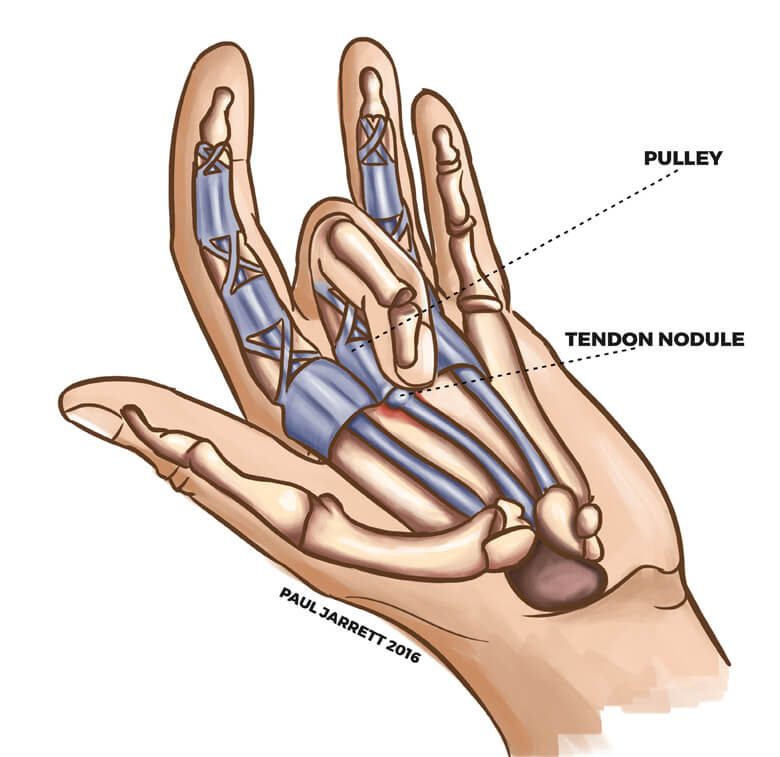
Trigger Digit
A trigger digit sufferer will experience discomfort or pain in the palm of the hand at the base of the affected finger(s) and often a clicking feeling when moving the finger(digit), especially when bending and straightening. The digit may get caught down in the palm of the hand, and it may be necessary to pull it straight again with a painful click.
In a milder form of the trigger digit condition, the symptoms of trigger digit may differ. The clicking and catching down in the palm may be absent, but the discomfort is present. Trigger finger or trigger thumb can appear gradually, or rapidly, and may resolve spontaneously over time or remain indefinitely without treatment.
The flexor tendons that bend your fingers run within a tunnel called the fibrous flexor sheath, from the end of your palm into your finger as shown in the diagram below. The mouth of the sheath (A1 pulley) is narrower than the main part of the tunnel.
In a trigger digit, a small swelling develops in the tendon which catches in the mouth of the sheath as the tendon glides in and out of the sheath. The clicking feeling represents the swelling catching at the mouth flexor sheath. The cause of the majority of swellings causing a trigger digit is not known, however, fortunately, there is an effective treatment is available.

How is trigger digit (trigger finger) treated?
Mild cases of trigger digit may heal without treatment. This can be aided by resting the hand and avoiding repetitive use for a week or so. For more severe triggering, the main treatment options are hand therapy and steroid injections.
Hand therapy involves exercises and at times the use of splints.
Steroid injections involve injecting minuscule amounts of steroid into the affected area. The steroid remains at the injection site and aims to reduce the swollen area in the tendon. A single injection resolves a triggering digit in over 50% of cases, and a further one or two injections will usually result in over 70% of trigger digits resolving after the steroid injection treatment.
Steroid injections are safe and may be carried out by your family doctor or the radiologists or Mr Jarrett as the first line of treatment for trigger digits. Steroid injection treatment aims to provide a permanent resolution of the triggering. Steroid injections have a reduced chance of success if you have diabetes, or especially if you have had a carpal tunnel decompression in the past. There is a risk of infection with steroid injection and a very small risk of tendon rupture or skin discolouration or indentation.
If steroid injections are unsuccessful, a minor operation called trigger release is available. Involving a small wound in the palm, this procedure is usually carried out under local anaesthetic, although general anaesthetic can be used if you prefer. The mouth of the sheath in which the flexor tendon travels is cut to prevent the triggering, and the condition resolves following this procedure.
Trigger Release Post-Operative Care
A small bandage is worn for two days. Upon removal of the bandage the small sticky plaster is worn for a further 7 days, and then removed. I use absorbable sutures which do not require removal. The wound is usually tender for a few weeks, resolving over this period. From 10 days after your operation, you can commence washing your hand as normal, and I would recommend massaging the wound with moisturising lotion twice daily. The small white sutures will fall out by themselves over a few days and do not require formal removal by a nurse or doctor.
The fingers can be moved immediately following the procedure, but heavy work may not be possible until the wound has healed. The risks of the procedure are low but include infection (1%), stiffness and nerve injury (rare).